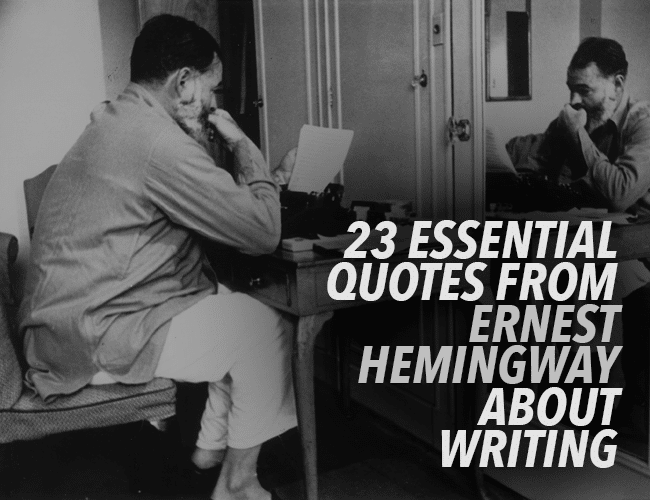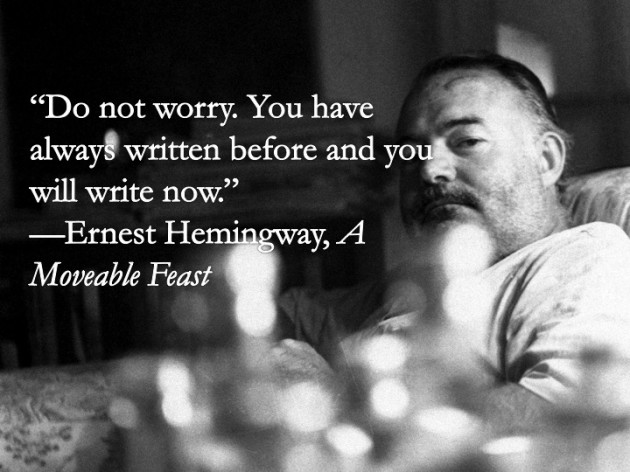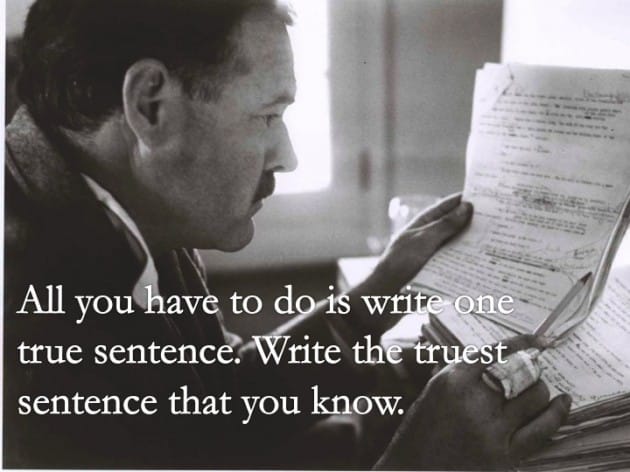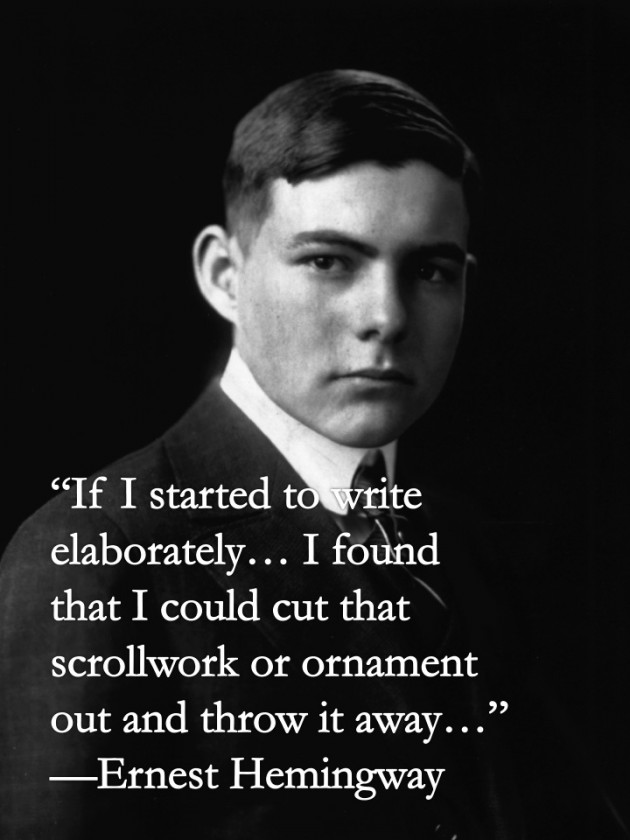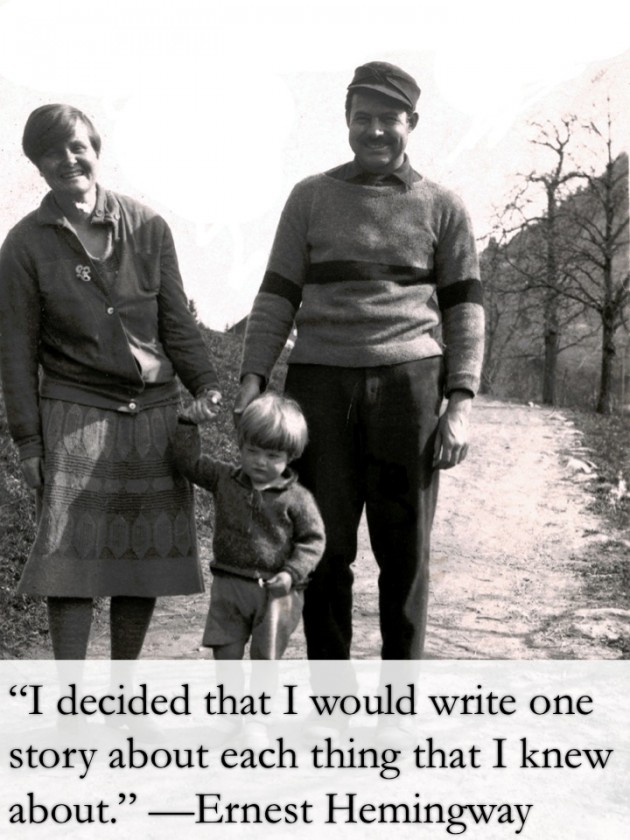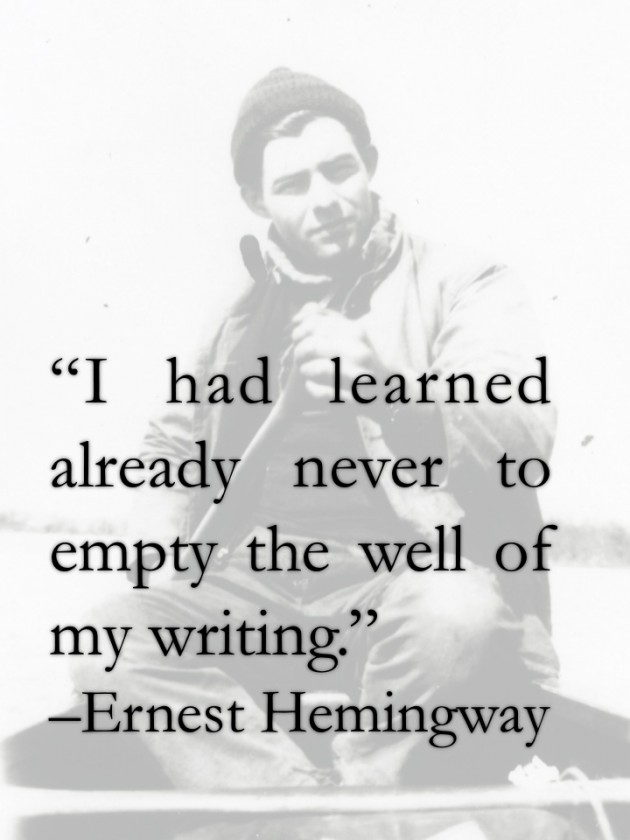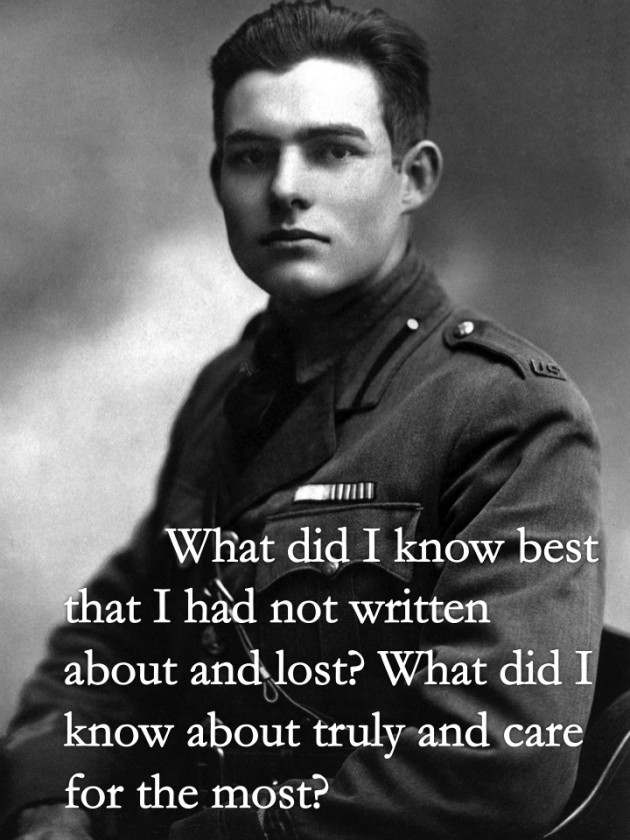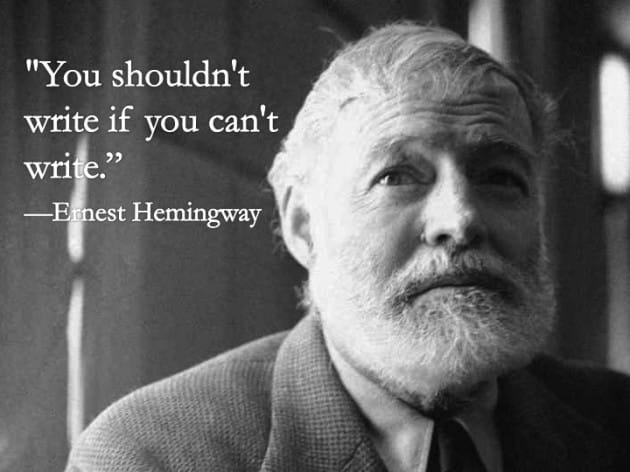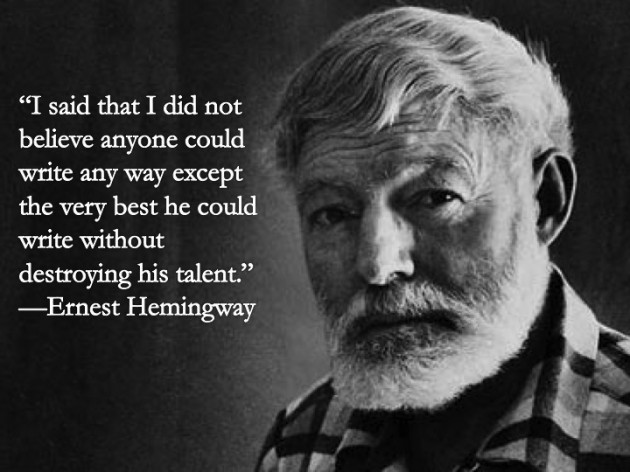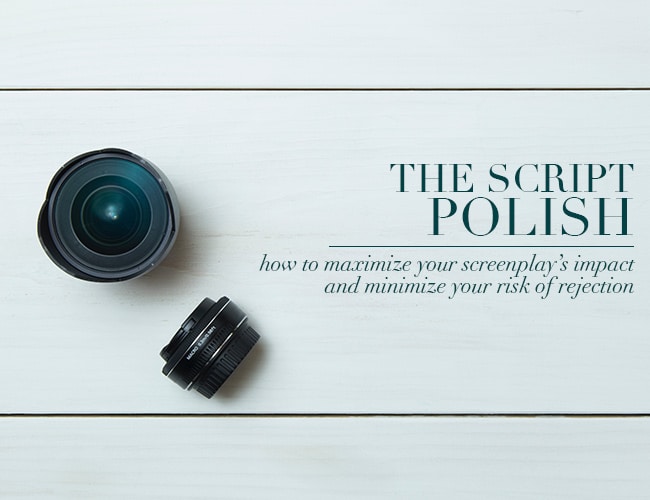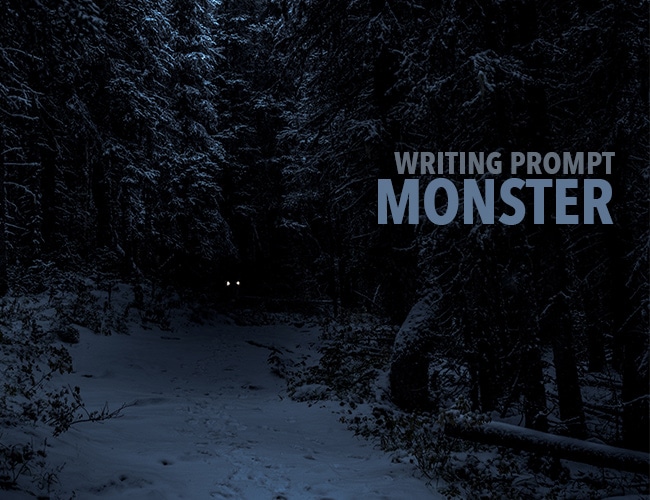Ernest Hemingway was one of the most influential writers of the 20th century. Writers such as J.D. Salinger and Ray Bradbury have claimed Hemingway as an influence. Most writers seem to either love him — and are influenced by his clear, direct prose — or hate him. John Irving said he objected to the “offensive tough-guy posturing — all those stiff-upper-lip, don’t-say-much men.”
Regardless of your personal feelings, Hemingway’s insight into the craft of writing is unparalleled, as you’ll see.
Hemingway’s Writer Life
When my English Literature professor, Marilyn McEntyre, told us Hemingway would write all day in small Parisian cafes and, afterward, take his lunch to the Musée du Luxembourg where he would look at Cezannes, it transformed how I looked at authors — and writing, for that matter — forever.
In college, I read Faulkner, Dostoyevsky, Tolstoy and all the other writers infamous among college students everywhere. The authors, if I had imagined them, were like statues in some museum, old cracked marble missing limbs, dust piled atop their heads. They were empty-eyed faces carved into cathedral stone, looking down on us to make sure we knew their names. If we misremembered, they would denounce us before God at those golden gates.
But Dr. McEntyre’s story tore the veil. I saw Hemingway drinking cups of French coffee at a cafe with black and white pictures on the wall, writing slowly, with lots of crossouts. I saw him with his sacked lunch, made by his loving first wife Hadley, drinking out of a thermos (did they have those in the 1920s?) and tracing those bold brushstrokes with his eyes. He had intense blue eyes.
Writers, I realized, were somehow not part of the evil plan hatched by professors to torture their students, but real people, with real ambitions and insecurities. I’ve heard the point of art is not communication, but I realized then they were trying to give something to me, some greater perspective of the world maybe. Or even just an enjoyable afternoon.
The Writer’s Inheritance
When I began learning about Hemingway’s life and influences, it helped me to realize that to transform the way I approached writing, I needed to see myself as part of the tradition. There is a great continuum in this art form, an inheritance that every writer can and should apprentice themselves to.
But there is a divergence in Hemingway. He didn’t apprentice himself just to writers. He looked to a painter to transform his work.
When he visited the Musée de Luxembourg, he didn’t just glance at the Cezannes. He studied them, and invited the artist to influence his writing.
What did Hemingway learn from Cezanne?
I wish I were more of an expert in art, but I do know Cezanne believed in using big bold brush strokes. His painting of Saint Victoire mountains could have been done with on an iPhone. Strong strokes construct the landscape like Lincoln logs.
Hemingway believed each word was a brush stroke on the page. Some people have called Hemingway’s prose childish and simplistic, but his genius was his use of a few strong words to do so much work. He used few adjectives. His prose is full of action, not decor, and so when an occasional bit of color is revealed, it fills in the whole image.
Learn From Hemingway Learning From Cezanne
It’s your turn to enter into the literary tradition, to write your way into your inheritance. Just as Hemingway studied the Cezannes at the Musée de Luxembourg, take time to study Hemingway’s writing.
The good news is, Hemingway had lots of advice for other writers. Which of his tips will you try in your writing next?
23 Ernest Hemingway Quotes for Writers
All of Ernest Hemingway’s quotes in this article are from A Moveable Feast, Ernest Hemingway‘s memoir about his life as a writer in Paris:
1. “Do not worry. You have always written before…”
I would stand and look out over the roofs of Paris and think, “Do not worry. You have always written before and you will write now.”
2. All You Need to Write Is…
The blue-backed notebooks, the two pencils and the pencil sharpener (a pocket knife was too wasteful), the marble topped tables, the smell of early morning, sweeping out and mopping, and luck were all you needed. For luck, you carried a horse chestnut and a rabbit’s foot in your right pocket.
3. Write One True Sentence
“All you have to do is write one true sentence. Write the truest sentence that you know.” So finally I would write one true sentence, and then go on from there. It was easy then because there was always one true sentence that I knew or had seen or had heard someone say.
4. Cut Out the Ornamentation
If I started to write elaborately, or like someone introducing or presenting something, I found that I could cut that scrollwork or ornament out and throw it away and start with the first true simple declarative sentence I had written.
5. Don’t Think About Your Writing When You’re Not Writing
It was in that room too that I learned not to think about anything that I was writing from the time I stopped writing until I started again the next day. That way my subconscious would be working on it and at the same time I would be listening to other people and noticing everything.
6. Write as Straight as You Can
Ernest Hemingway to F. Scott Fitzgerald:
“Write the best story that you can and write it as straight as you can.”
7. Write What You Know
Up in that room I decided that I would write one story about each thing that I knew about. I was trying to do this all the time I was writing, and it was good and severe discipline.
8. Allow Painters to Influence You
I was learning something from the painting of Cézanne that made writing simple true sentences far from enough to make the stories have the dimensions that I was trying to put in them. I was learning very much from him but I was not articulate enough to explain it to anyone. Besides it was a secret.
9. Don’t Repeat Yourself
This book began magnificently, went on very well for a long way with great stretches of great brilliance and then went on endlessly in repetitions that a more conscientious and less lazy writer would have put in the waste basket.
10. Exercise
It was necessary to get exercise, to be tired in the body, and it was very good to make love with whom you loved. That was better than anything. But afterwards, when you were empty, it was necessary to read in order not to think or worry about your work until you could do it again.
11. Never Empty the Well of Your Writing
I had learned already never to empty the well of my writing, but always to stop when there was still something there in the deep part of the well, and let it refill at night from the springs that fed it.
12. After You Write, Read
When I was writing, it was necessary for me to read after I had written. If you kept thinking about it, you would lose the thing that you were writing before you could go on with it the next day.
13. Let the Pressure Build
When I had to write it, then it would be the only thing to do and there would be no choice. Let the pressure build. In the meantime I would write a long story about whatever I knew best.
14. What Do You know Best?
What did I know best that I had not written about and lost? What did I know about truly and care for the most? There was no choice at all.
15. Omit Anything You Want (As Long As You Know You’re Doing It)
It was a very simple story called “Out of Season” and I had omitted the real end of it which was that the old man hanged himself. This was omitted on my new theory that you could omit anything if you knew that you omitted and the omitted part would strengthen the story and make people feel something more than they understood.
16. Stay Sound in Your Head
All I must do now was stay sound and good in my head until morning when I would start to work again.
17. If You Can’t Write, Don’t Write
To an aspiring writer: “You shouldn’t write if you can’t write.”
18. It’s Okay to Be Shy
… [F. Scott Fitzgerald] had the shyness about it that all non-conceited writers have when they have done something very fine.
19. But Don’t Pimp Your Writing
[F. Scott Fitzgerald] had told me at the Closerie des Lilas how he wrote what he thought were good stories, and which really were good stories for the Post, and then changed them for submission, knowing exactly how he must make the twists that made them into salable magazine stories. I had been shocked at this and I said I thought it was whoring…. I said that I did not believe anyone could write any way except the very best he could write without destroying his talent.
20. Break Down Your Writing
Since I had started to break down all my writing and get rid of all facility and try to make instead of describe, writing had been wonderful to do. But it was very difficult, and I did not know how I would ever write anything as long as a novel. It often took me a full morning of work to write a paragraph.
21. Forget Living the “Literary Life”
I was getting tired of the literary life, if this was the literary life that I was leading, and already I missed not working and I felt the death loneliness that comes at the end of every day that is wasted in your life.
22. Don’t Drink While You Write
My training was never to drink after dinner nor before I wrote nor while I was writing.
23. Don’t Judge Your Writing Until the Next Day
After writing a story I was always empty and both sad and happy, as though I had made love, and I was sure this was a very good story although I would not know truly how good until I read it over the next day.
Bonus Quotes from Hemingway’s Mentors
The following are not Ernest Hemingway’s quotes. Instead, they are tips to Ernest Hemingway from his friends and mentors which he captured in A Moveable Feast:
24. Be Careful About Writing About Sex
“It’s good,” [Gertrude Stein] said. “That’s not the question at all. But it is inaccrochable. That means it is like a picture that a painter paints and then he cannot hang it when he has a show and nobody will buy it because they cannot hang it either.”
innacroachable, def (via Wiktionary)
- (of a painting) unable to be hung (or sold), especially because of its sexual content
- (of a book) unable to be published, for the same reason
25. What We Lack Most
“We need more true mystery in our lives, Hem,” [Evan Shipman] once said to me. “The completely unambitious writer and the really good unpublished poem are the things we lack most at this time. There is, of course, the problem of sustenance.”
26. Only Read What Is Good
Gertrude Stein told Ernest Hemingway:
You should only read what is truly good or what is frankly bad.
Which of these Ernest Hemingway quotes is your favorite? Let us know in the comments.
PRACTICE
I love Hemingway’s questions for himself, “What did I know best that I had not written about and lost? What did I know about truly and care for the most?”
Ask those questions of yourself, then write whatever story comes to mind.
For this practice, write for fifteen minutes. When your time is up, post your practice in the comments section below to get feedback. Afterward, feel free to continue working on your story. And if you post, please make sure to give feedback to other writers.
Download the step-by-step guide and learn how to become a writer today.
The post 23 Essential Quotes From Ernest Hemingway About Writing appeared first on The Write Practice.
from The Write Practice https://ift.tt/2BZLRPH
